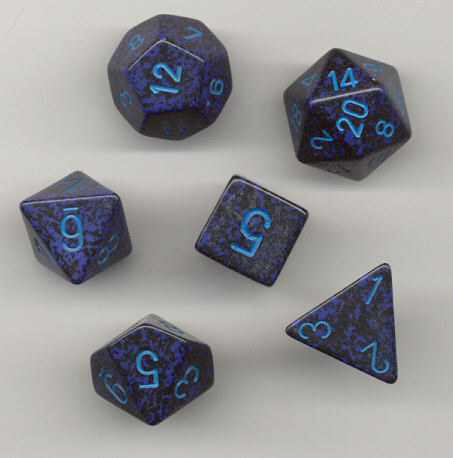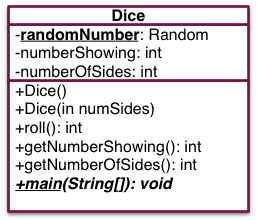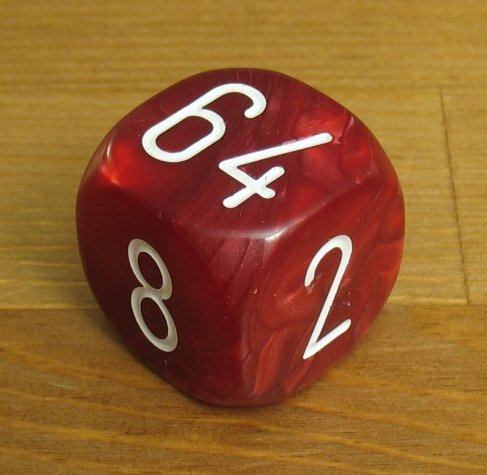


ICT-4361 Homework 3a
Purpose
Extending our dice exercise will show how to
create multiple constructors, and
apply another layer of abstraction on top of our class. We will be
moving our dice class to handle configurable sides, and allowing
different dice to have different numbers of sides.
We will be using multiple Dice objects and compute the total number showing.
What to Hand In
Please hand in a listing for each program
requested, formatted in an easy-to-read style, and following our Java conventions.
Ensure your name, and the name of the file is
available in a comment at the top of each submitted file (excepting screenshots).
Also, ensure that you have a sample of the
output from the program.
If your program fails to compile, hand in your
error listing as your output.
For each question asked, provide one or two
sentences summarizing your answer. Please be both complete and
succinct.
Submit the files comprising your submission in a single "zip" or similar archive through the assignment's submission button.
File types of .java, .txt, .jpg, and .png are preferred within the archive.
Problems
-
Different Dice for different folks
.
-
Modify your Diceclass to add a new private int field,numberOfSides. -
Create (or modify) a default constructor for the Dice class that sets the number of sides to 6. It should set the numberOfSides field for that instance of dice to 6. -
Add a new constructor that takes an integer argument that allows you to create a different number of sides for a dice. It should set the numberOfSides field for that instance of dice to the argument. -
Make the Randominstance a static attribute. That is, you will have one instance of theRandomclass that services all the Dice objects. -
Modify your roll()method to take into account thenumberOfSideson the Dice object.
You should not add any parameters to Diceroll()method. -
Modify (or create) the mainmethod of theDiceclass, ensuring you account for the new range of totals, and test the new constructor. -
Capture the output of this run.
-
-
We totally get it!
-
Create a new Dice class client called TwoDice, with amainmethod. -
In the main method of TwoDice, create two Dice objects, calleddiceOneanddiceTwo. -
Initialize diceOneusing the zero-parameter constructor. InitializediceTwowith the integer constructor, creating a dice with four sides. -
Create an int array called totalsthat is large enough to have an index equal to the highest sum of the two dice'snumberShowing. -
Set up a loop to run 100,000 times (or more), with the maximum being the value of a variable in the main method. -
In each iteration of the loop, roll each dice, and add one to the value of totals[sum], where sum representsdiceOne.getNumberShowing() + diceTwo.getNumberShowing() -
After the loop has completed, the descriptions of the Dice should be output, as well as the contents of the totals array. Each index represents a possible total, and each value in the array represents how many times that total occurred. -
Capture the output of this run.
-
- Imagine that we wished to change the Dice class to allow for Dice not sequentially numbered from one to the number of faces (say, a backgammon doubling cube). Describe (in a short text paragraph) what would need to change to support this approach.
Notes
-
The new fields in Dice should have privatevisibility. -
Be sure to have public getters available for the numberShowing and numberOfSides fields. -
Remember to initialize your instance of Random!
Evaluation
| Criteria | Weight |
|---|---|
| New instance attribute | 15% |
| Default constructor | 15% |
| Integer constructor | 15% |
| New static attribute | 15% |
| Problem I main program and output | 15% |
| Problem II main program and output | 15% |
| Short textual answer to question III (in a text document, or comment in the code) | 10% |